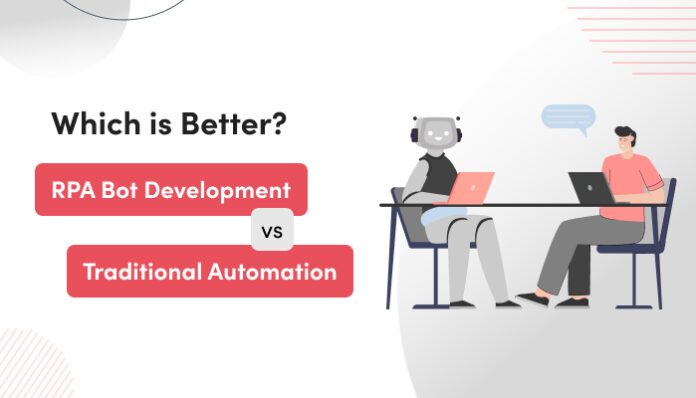Automation has long been a driving force behind operational efficiency and productivity gains in various industries. However, with the rise of robotic process automation (RPA), a new paradigm has emerged, challenging traditional automation methods.
Let’s dive into the key differences between RPA bot development and traditional automation, shedding light on their distinct approaches and highlighting the unique advantages and considerations associated with each.
What is Traditional Automation?
We’ll begin by defining what traditional automation really is. It typically relies on pre-programmed scripts or macros to execute repetitive tasks. It often requires significant upfront investment, customization, and maintenance to integrate with existing systems and workflows.
The Definition of RPA
RPA is a technology that uses software “bots” to automate routine, rule-based processes that are traditionally done by people. These bots carry out processes including data entry, data manipulation, and transaction processing by interacting with programs, systems, and data in a manner identical to that of a human user.
The Differences Between RPA and Traditional Automation
Now, we’ll go over the differences between these two powerful technologies.
Technology
Traditional automation relies primarily on APIs, programming, and integrated methods to automate tasks. On the other hand, RPA operates at the user interface (UI) level, replicating user actions.
This means that RPA interacts with applications and systems just like a human user, making it more versatile in handling a wider range of processes.
Software Limitations
One significant advantage of RPA over traditional automation is its ability to work with systems that lack APIs or are built on legacy technologies.
RPA bots can navigate and interact with applications and systems directly without the need for underlying APIs. This makes RPA a valuable solution for organizations that rely on legacy systems or have complex IT landscapes.
Turnaround Time
RPA offers several advantages when it comes to turnaround time. It is fast and easy to implement, thanks to its user-friendly interfaces and drag-and-drop functionality. RPA also has a short learning curve for users, enabling business users to create and deploy automation bots with minimal coding expertise.
The adaptability of RPA allows organizations to quickly automate processes and make adjustments as needed, facilitating faster implementation and responsiveness to changing business requirements.
Customization
Compared to traditional automation, RPA provides a high level of customization options. RPA solutions often offer intuitive visual interfaces, allowing users to configure and customize automation workflows to suit their specific needs. This flexibility enables organizations to tailor the automation process precisely, optimizing it for their unique business requirements.
Cost Efficiency
RPA demonstrates cost efficiency by handling complexities with less effort compared to traditional automation procedures. RPA bots can handle tasks that involve cognitive abilities such as natural language processing and decision-making, reducing the manual effort required.
The ability to automate processes without relying on underlying APIs or legacy systems eliminates the need for extensive integration efforts and potential associated costs.
Platform Agnostic
RPA is a platform-agnostic approach to automation. It can be utilized to automate any process or part of any application on any platform. This flexibility allows organizations to apply RPA across various systems, applications, and platforms, enabling comprehensive automation across the entire IT landscape.
By considering these key differences between RPA and traditional automation, organizations can make informed decisions regarding the most suitable automation approach for their specific needs.
RPA’s user-friendly nature, ability to handle complex tasks, adaptability, customization options, cost efficiency, and platform-agnostic nature make it a compelling choice for many organizations looking to enhance their automation capabilities.
So, Which Technology is Better?
When comparing RPA to traditional automation, it becomes evident that RPA possesses numerous advantages that make it a compelling choice for organizations. Its flexibility, scalability, customization options, and cost efficiency stand out as notable benefits.
RPA’s ability to operate at the user interface level grants it the flexibility to interact with various applications and systems without relying on APIs or extensive integration efforts. This adaptability makes RPA well-suited for organizations with diverse IT environments or legacy systems.
RPA offers scalability, enabling organizations to automate processes incrementally and expand automation initiatives as needed. With user-friendly interfaces and intuitive tools, RPA empowers business users to configure and customize automation workflows to suit their specific requirements.
This level of customization enhances the adaptability and responsiveness of RPA, ensuring that automation aligns closely with the organization’s unique needs and processes.
Cost efficiency is another advantage of RPA bot development. By streamlining complex tasks and reducing manual effort, RPA can deliver cost savings and operational efficiency.
The elimination of extensive integration efforts and the ability to work with applications across platforms contribute to cost savings by reducing the need for complex and costly IT projects.
It’s important to note that the choice between RPA and traditional automation should be based on careful consideration of the specific requirements and context of each organization.
Depending on factors such as the nature of the tasks to be automated, the existing IT infrastructure, and the level of expertise within the organization, traditional automation may still be a viable option in certain scenarios.
Organizations must assess their unique needs, consider the benefits and limitations of each approach, and determine which technology aligns best with their goals and resources.
Whether it’s the flexibility and scalability of RPA or the suitability of traditional automation, the selection should be driven by a thorough understanding of the organization’s automation requirements and the potential impact on efficiency, productivity, and overall business operations.
Final Thoughts
The key differences between RPA bot development and traditional automation highlight the unique advantages that each technology offers. RPA stands out with its versatility, software limitations, fast turnaround time, high level of customization, cost efficiency, and platform-agnostic nature. These benefits make RPA a compelling choice for organizations seeking to enhance their automation capabilities.
However, it’s important to consider the specific needs and context of each organization when choosing between RPA and traditional automation. Factors such as the nature of tasks, existing IT infrastructure, and expertise within the organization should be carefully evaluated to determine the most suitable automation approach.
The selection should be driven by a thorough understanding of the organization’s automation requirements and the potential impact on efficiency, productivity, and overall business operations.
Don’t let the complexities of RPA implementation hold you back. Organizations like yours can successfully implement RPA solutions, driving efficiency, productivity, and cost savings. Take the next step toward transforming your organization with the power of automation.















